Azimuthal Variation in the Surface-Wave Velocity in the Arabian Plate
Abstract
:1. Introduction
2. Data, Methodology and Results
3. Interpretation and Discussion
4. Conclusions
Supplementary Materials
Funding
Institutional Review Board Statement
Informed Consent Statement
Data Availability Statement
Acknowledgments
Conflicts of Interest
References
- Al-Lazki, A.; Ebinger, C.; Kendall, K.; Helffrich, G.; Leroy, S.; Tiberi, C.; Stuart, G.; Al-Toobi, K. Upper mantle anisotropy of southeast Arabia passive margin [Gulf of Aden northern conjugate margin], Oman. Arab. J. Geosci. 2012, 5, 925–934. [Google Scholar] [CrossRef]
- Elsheikh, A.A. Seismic anisotropy and mantle flow beneath East Africa and Arabia. J. Afr. Earth Sci. 2019, 149, 97–108. [Google Scholar] [CrossRef]
- Kim, R.; Witek, M.; Chang, S.-J.; Lim, J.-A.; Mai, P.M.; Zahran, H. Isotropic and radially anisotropic S-velocity structure beneath the Arabian plate inferred from surface wave tomography. Tectonophysics 2023, 862, 229968. [Google Scholar] [CrossRef]
- Qaysi, S.; Liu, K.H.; Gao, S.S. A database of shear-wave splitting measurements for the Arabian Plate. Seismol. Res. Lett. 2018, 89, 2294–2298. [Google Scholar] [CrossRef]
- Corchete, V. Review of the methodology for the inversion of surface-wave phase velocities in a slightly anisotropic medium. Comput. Geosci. 2012, 41, 56–63. [Google Scholar] [CrossRef]
- Corchete, V. Crust and upper mantle structure of Mars determined from surface-wave analysis. Acta Astronaut. 2024. submitted. [Google Scholar]
- Corchete, V.; Chourak, M.; Hussein, H.M. Shear wave velocity structure of the Sinai Peninsula from Rayleigh wave analysis. Surv. Geophys. 2007, 28, 299–324. [Google Scholar] [CrossRef]
- Dziewonski, A.; Bloch, S.; Landisman, M. A technique for the analysis of transient seismic signals. Bull. Seismol. Soc. Am. 1969, 59, 427–444. [Google Scholar] [CrossRef]
- Cara, M. Filtering dispersed wavetrains. Geophys. J. R. Astron. Soc. 1973, 33, 65–80. [Google Scholar] [CrossRef]
- Corchete, V. The first 3D S-velocity model for the lithosphere-asthenosphere system of the Arabian Peninsula and the Iranian plateau. J. Seismol. 2024. submitted. [Google Scholar]
- Babuska, V.; Cara, M. Seismic Anisotropy in the Earth; Kluwer Academic: Dordrecht, The Netherlands, 1991. [Google Scholar]
- Priestley, K.; McKenzie, D.; Barron, J.; Tatar, M.; Debayle, E. The Zagros core: Deformation of the continental lithospheric mantle. Geochem. Geophys. Geosyst. 2012, 13, Q11014. [Google Scholar] [CrossRef]
- Pasyanos, M.E.; Masters, T.G.; Laske, G.; Ma, Z. LITHO1.0: An updated crust and lithospheric model of the Earth. J. Geophys. Res. Solid Earth 2014, 119, 2153–2173. [Google Scholar] [CrossRef]
- Kaviani, A.; Paul, A.; Moradi, A.; Mai, P.M.; Pilia, S.; Boschi, L.; Rümpker, G.; Li, Y.; Tang, Z.; Sandvol, E. Crustal and uppermost mantle shear wave velocity structure beneath the Middle East from surface wave tomography. Geophys. J. Int. 2020, 221, 1349–1365. [Google Scholar] [CrossRef]
- Park, Y.; Nyblade, A.A.; Rodgers, A.J.; Al-Amri, A. S wave velocity structure of the Arabian Shield upper mantle from Rayleigh wave tomography. Geochem. Geophys. Geosyst. 2008, 9, Q07020. [Google Scholar] [CrossRef]
- Krienitz, M.-S.; Haase, K.M.; Mezger, K.; van den Bogaard, P.; Thiemann, V.; Shaikh-Mashail, M.A. Tectonic events, continental intraplate volcanism, and mantle plume activity in northern Arabia: Constraints from geochemistry and Ar-Ar dating of Syrian lavas. Geochem. Geophys. Geosyst. 2009, 10, Q04008. [Google Scholar] [CrossRef]
- Chang, S.-J.; van der Lee, S. Mantle plumes and associated flow beneath Arabia and East Africa. Earth Planet. Sci. Lett. 2011, 302, 448–454. [Google Scholar] [CrossRef]
- Chang, S.-J.; Merino, M.; van Der Lee, S.; Stein, S.; Stein, C.A. Mantle flow beneath Arabia offset from the opening Red Sea. Geophys. Res. Lett. 2011, 38, L04301. [Google Scholar] [CrossRef]
- Yao, Z.; Mooney, W.D.; Zahran, H.M.; Youssef, S.E.H. Upper mantle velocity structure beneath the Arabian shield from Rayleigh surface wave tomography and its implications. J. Geophys. Res. Solid Earth 2017, 122, 6552–6568. [Google Scholar] [CrossRef]
- Tang, Z.; Mai, P.M.; Chang, S.-J.; Zahran, H. Evidence for crustal low shear-wave speed in western Saudi Arabia from multi-scale fundamental-mode Rayleigh-wave group-velocity tomography. Earth Planet. Sci. Lett. 2018, 495, 24–37. [Google Scholar] [CrossRef]
- Lim, J.-A.; Chang, S.-J.; Mai, P.M.; Zahran, H. Asthenospheric flow of plume material beneath Arabia inferred from S wave travel time tomography. J. Geophys. Res. Solid Earth 2020, 125, e2020JB019668. [Google Scholar] [CrossRef]
- Bosworth, W.; Huchon, P.; Mcclay, K. The Red Sea and Gulf of Aden Basins. J. Afr. Earth Sci. 2005, 43, 334–378. [Google Scholar] [CrossRef]
- Korostelev, F.; Basuyau, C.; Leroy, S.; Tiberi, C.; Ahmed, A.; Stuart, G.W.; Keir, D.; Rolandone, F.; Al Ganad, I.; Khanbari, K.; et al. Crustal and upper mantle structure beneath south-western margin of the Arabian Peninsula from teleseismic tomography. Geochem. Geophys. Geosyst. 2014, 15, 2850–2864. [Google Scholar] [CrossRef]
- Gashawbeza, E.M.; Klemperer, S.L.; Nyblade, A.A.; Walker, K.T.; Keranen, K.M. Shear-wave splitting in Ethiopia: Precambrian mantle anisotropy locally modified by Neogene rifting. Geophys. Res. Lett. 2004, 31, L18602. [Google Scholar] [CrossRef]
- Hansen, S.; Schwartz, S.; Al-Amri, A.; Rodgers, A. Combined plate motion and density-driven flow in the asthenosphere beneath Saudi Arabia: Evidence from shear-wave splitting and seismic anisotropy. Geology 2006, 34, 869–872. [Google Scholar] [CrossRef]
- Sadeghi-Bagherabadi, A.; Sobouti, F.; Ghods, A.; Motaghi, K.; Talebian, M.; Chen, L.; Jiang, M.; Ai, Y.; He, Y. Upper mantle anisotropy and deformation beneath the major thrust-and-fold belts of Zagros and Alborz and the Iranian Plateau. Geophys. J. Int. 2018, 214, 1913–1918. [Google Scholar] [CrossRef]
- Kaviani, A.; Mahmoodabadi, M.; Rumpker, G.; Pilia, S.; Tatar, M.; Nilfouroushan, F.; Yamini-Fard, F.; Moradi, A.; Ali, M.Y. Mantle-flow diversion beneath the Iranian plateau induced by Zagros’ lithospheric keel. Sci. Rep. 2021, 11, 2848. [Google Scholar] [CrossRef] [PubMed]
- Pilia, S.; Kaviani, A.; Searle, M.P.; Arroucau, P.; Ali, M.Y.; Watts, A.B. Crustal and mantle deformation inherited from obduction of the Semail ophiloite (Oman) and continental collision (Zagros). Tectonics 2021, 40, e2020TC006644. [Google Scholar] [CrossRef]
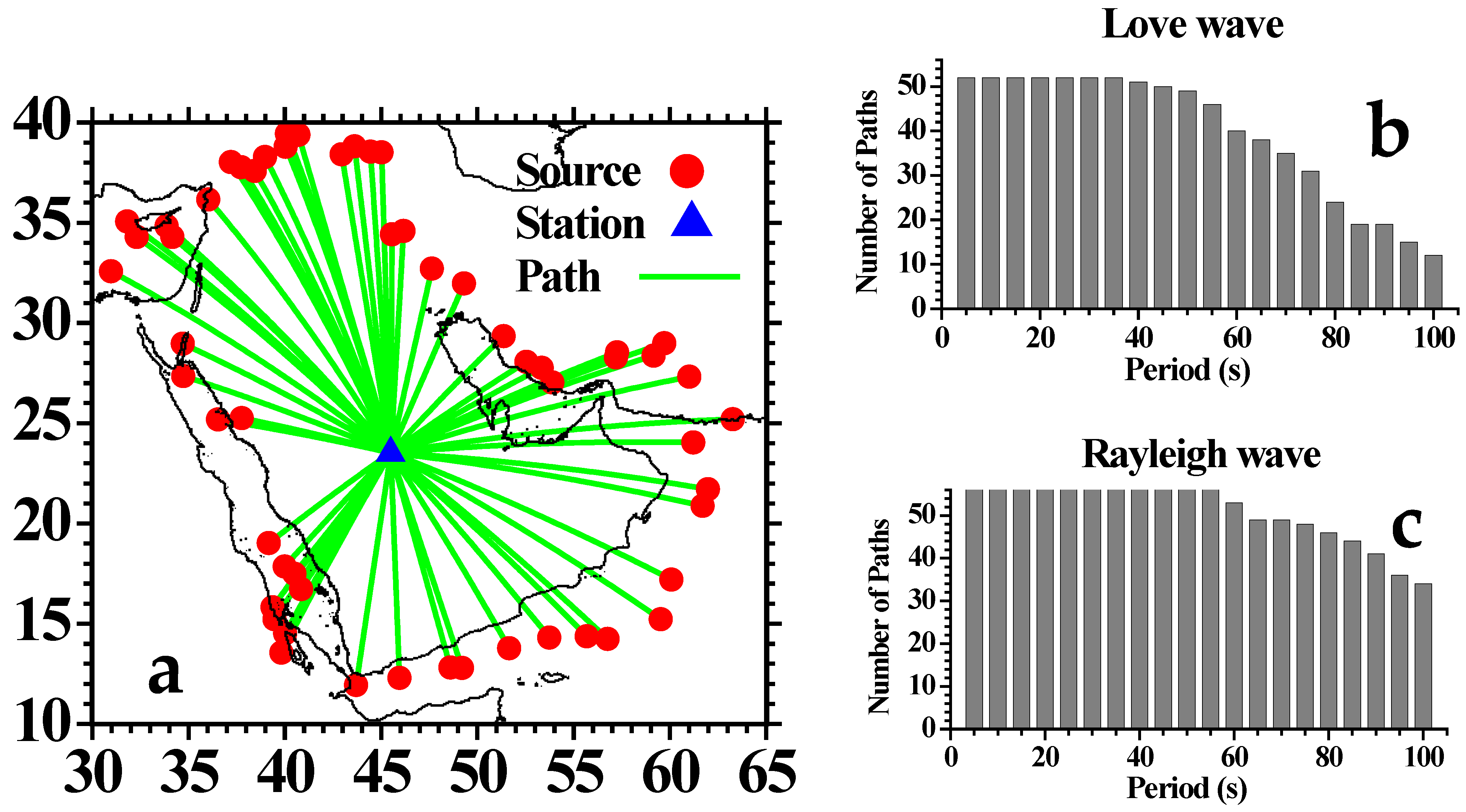
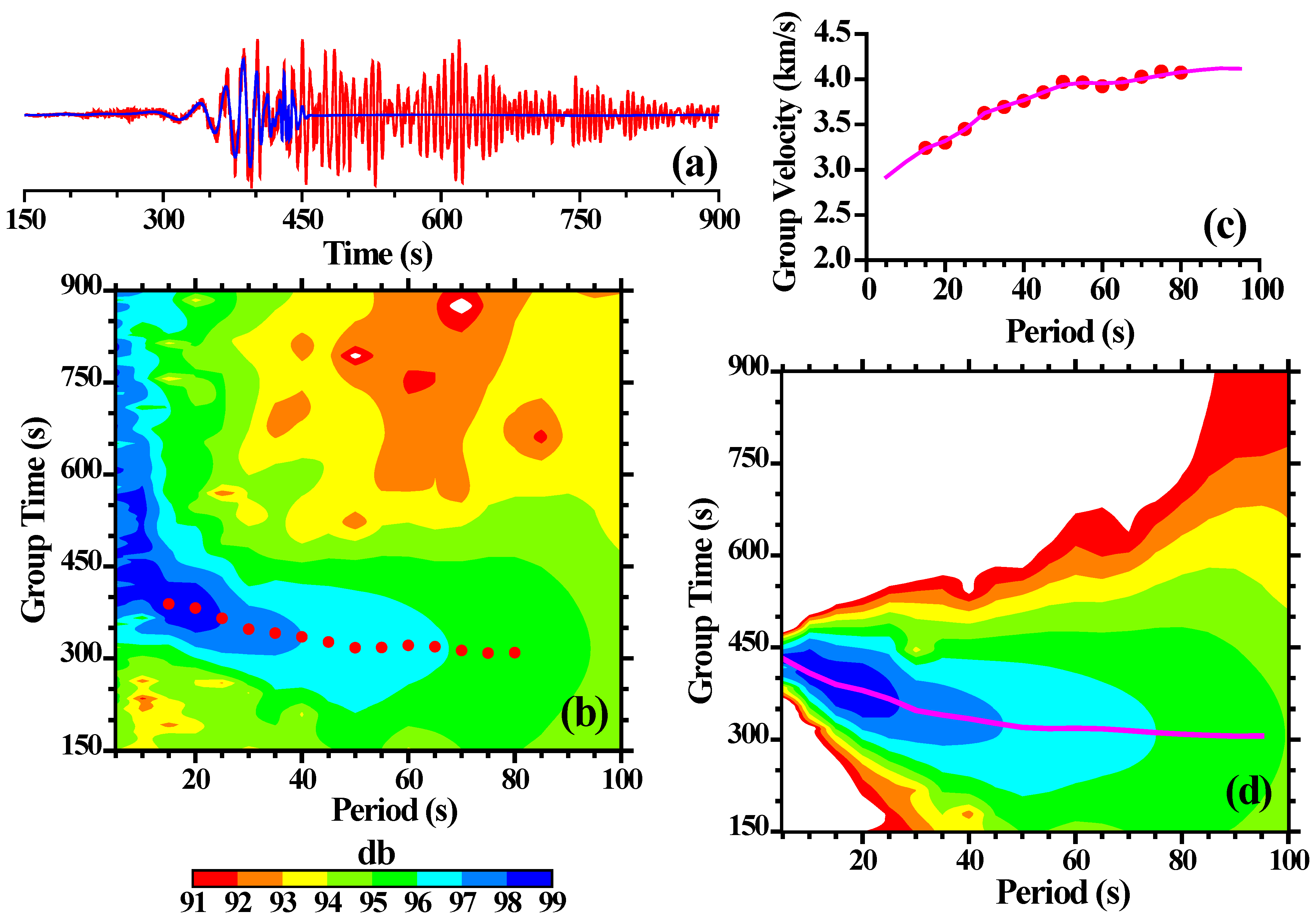
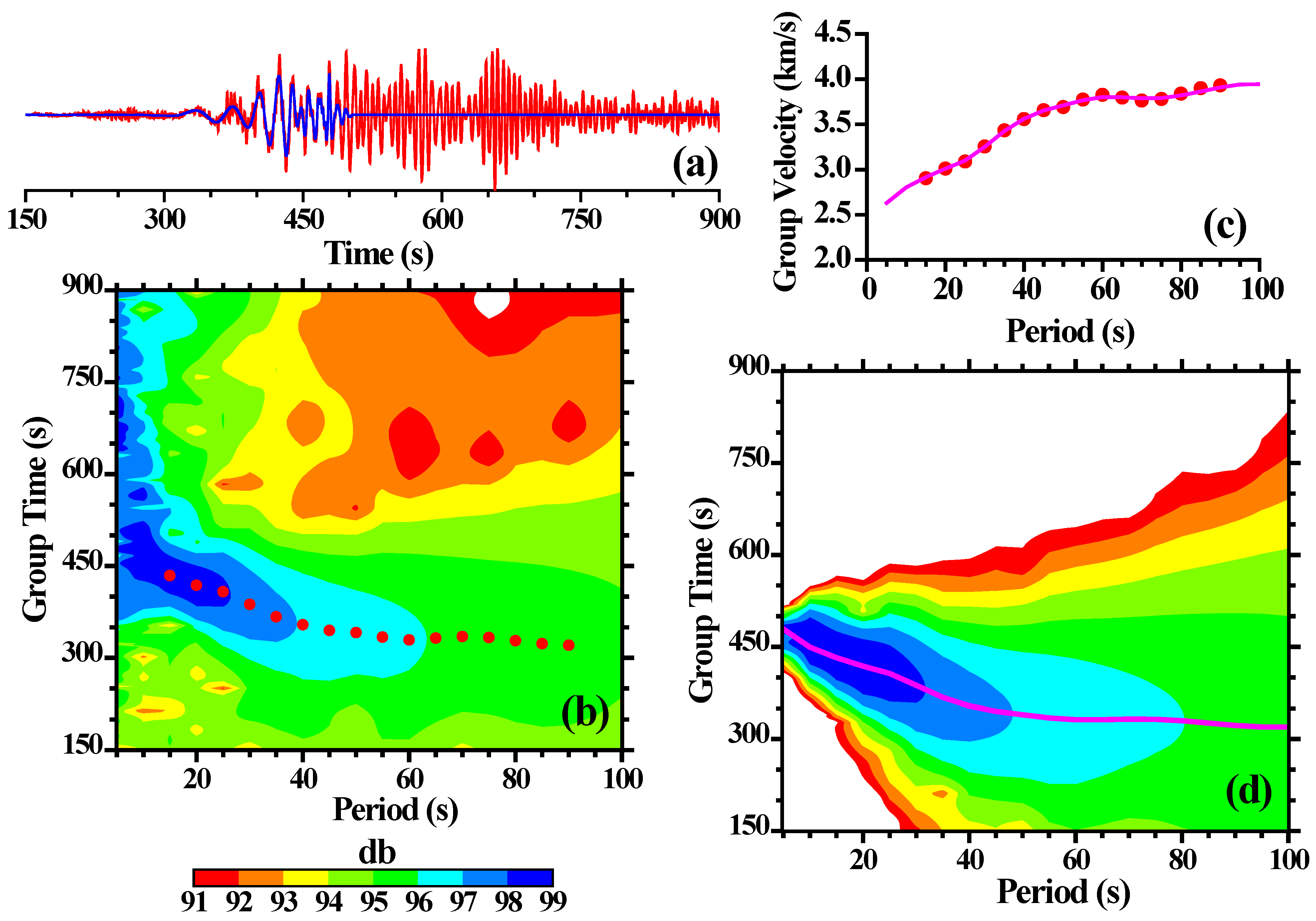
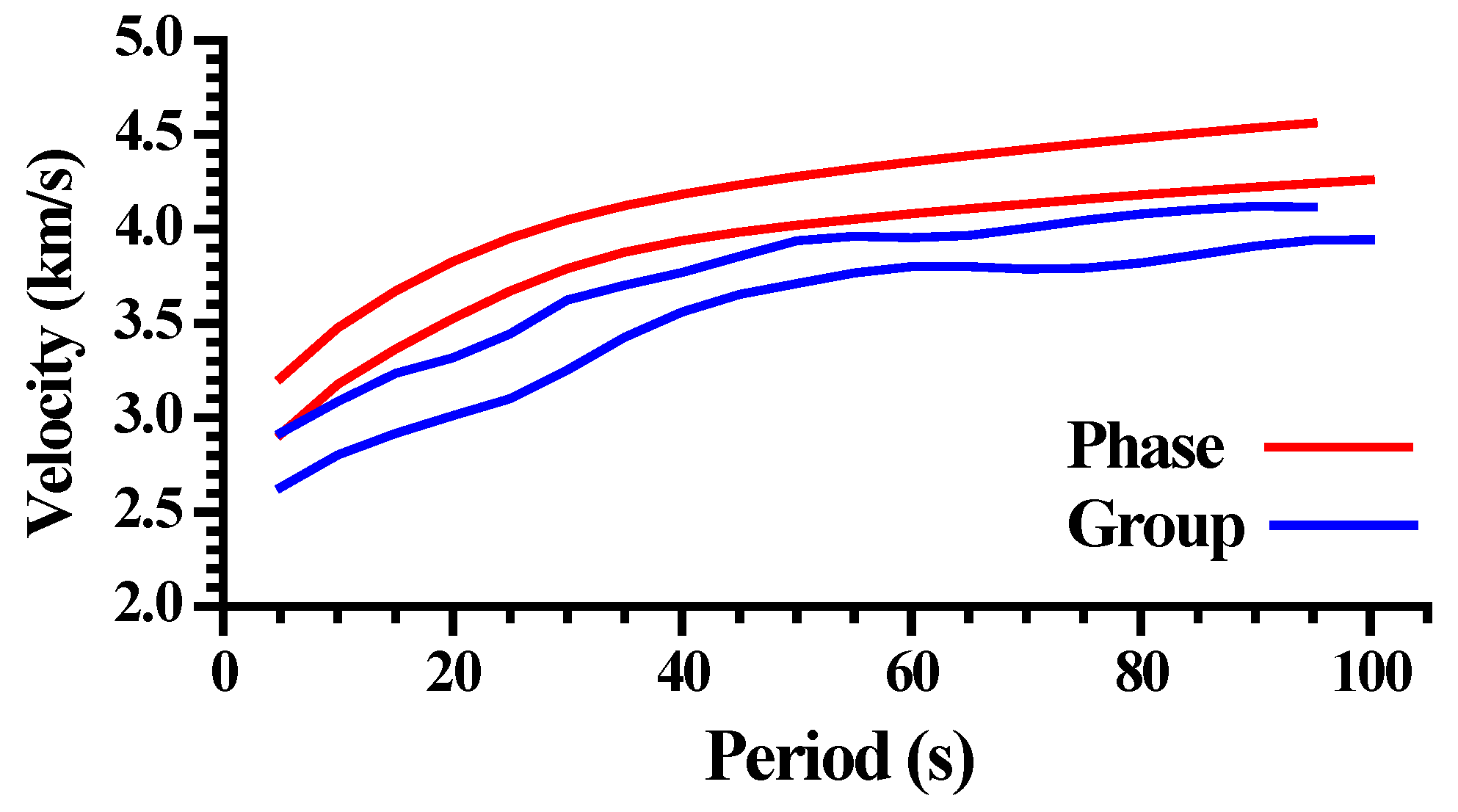
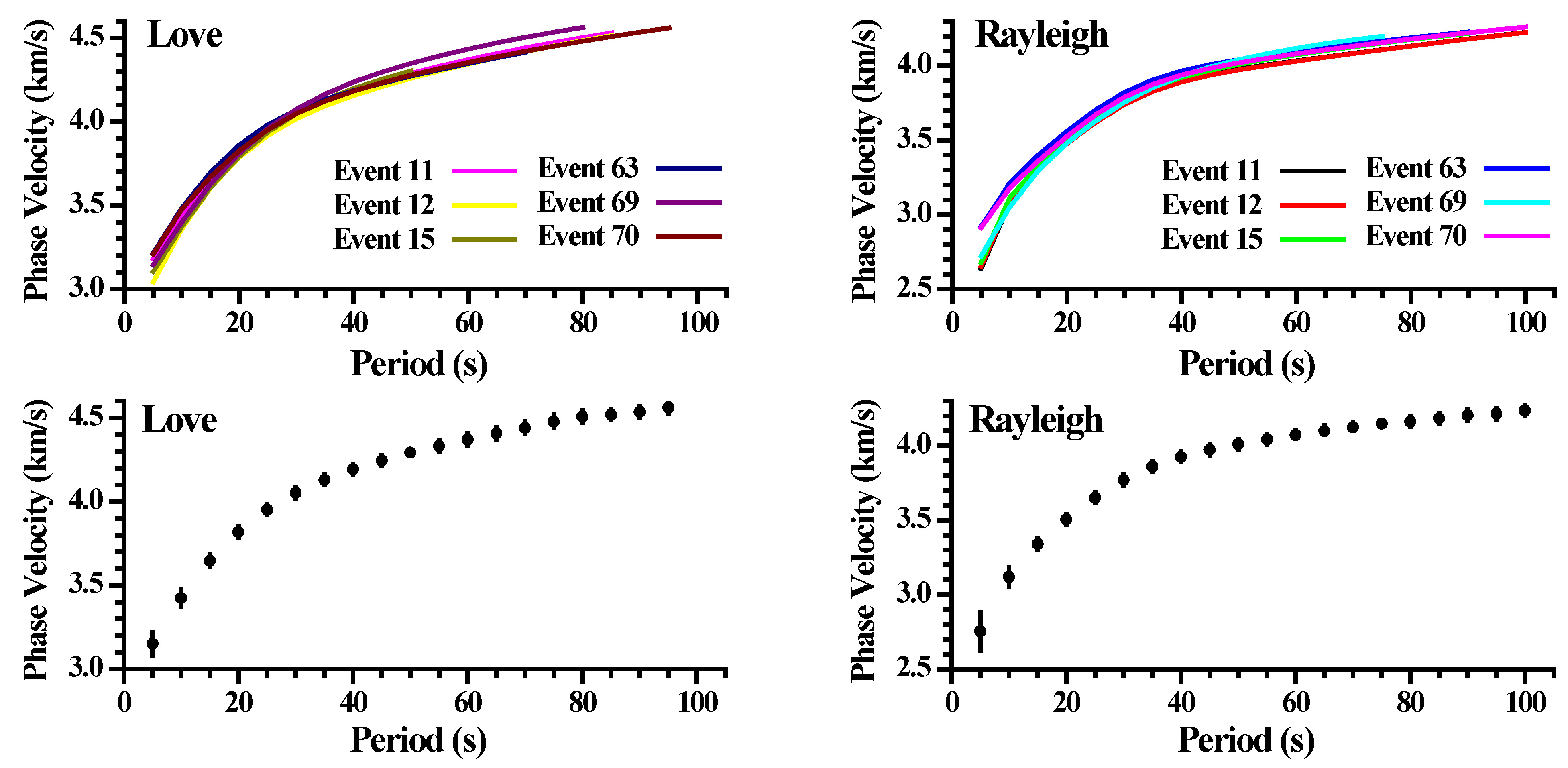
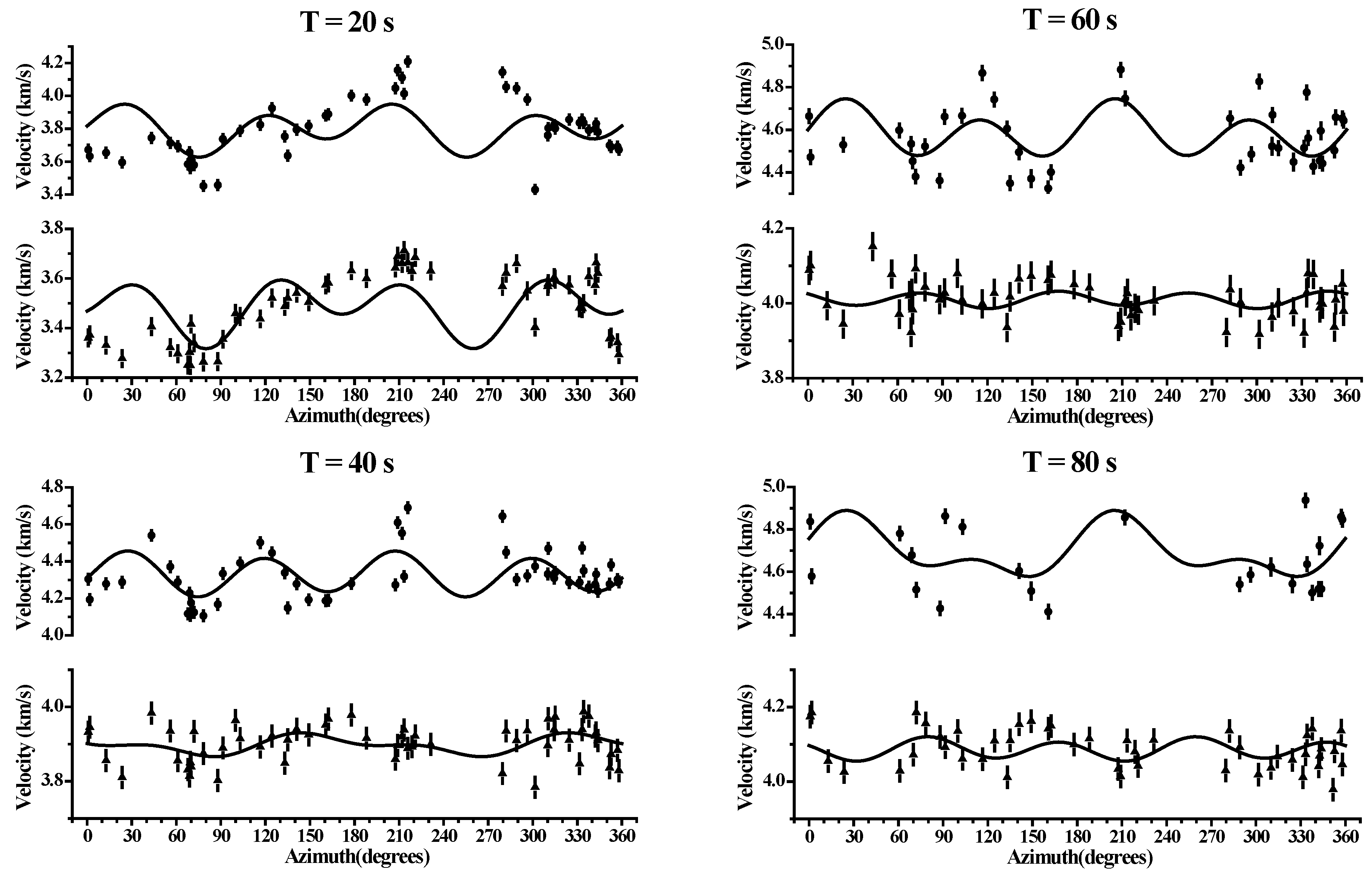
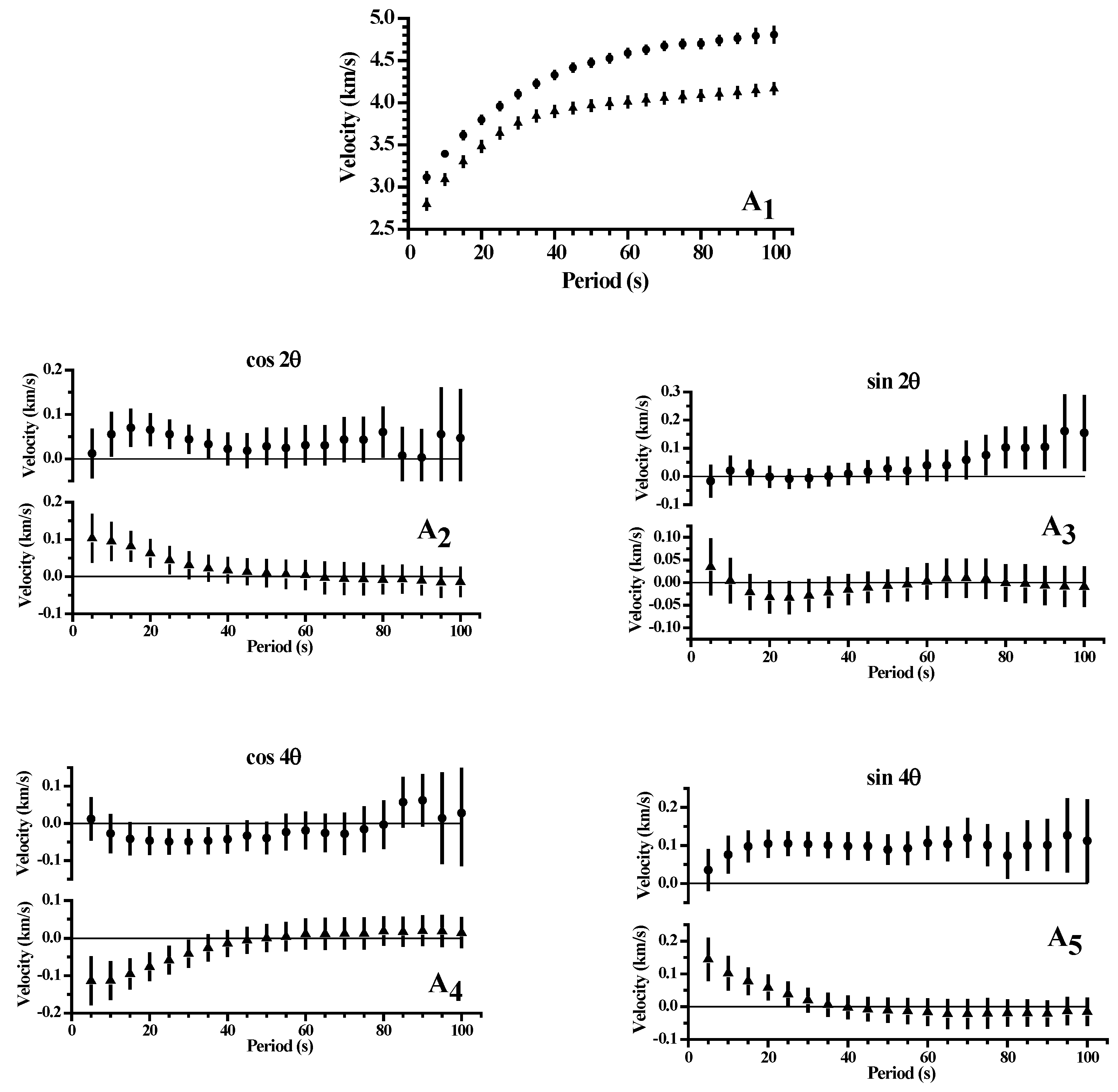


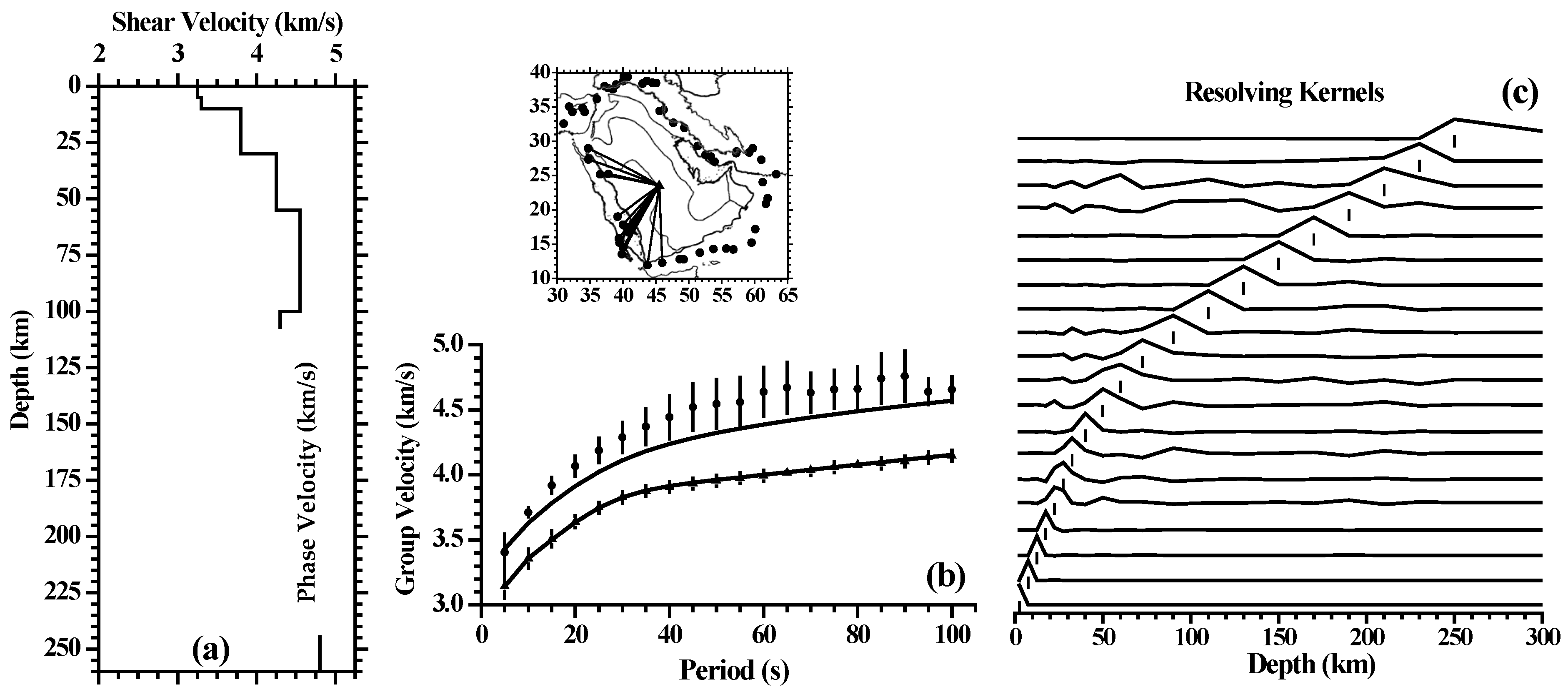
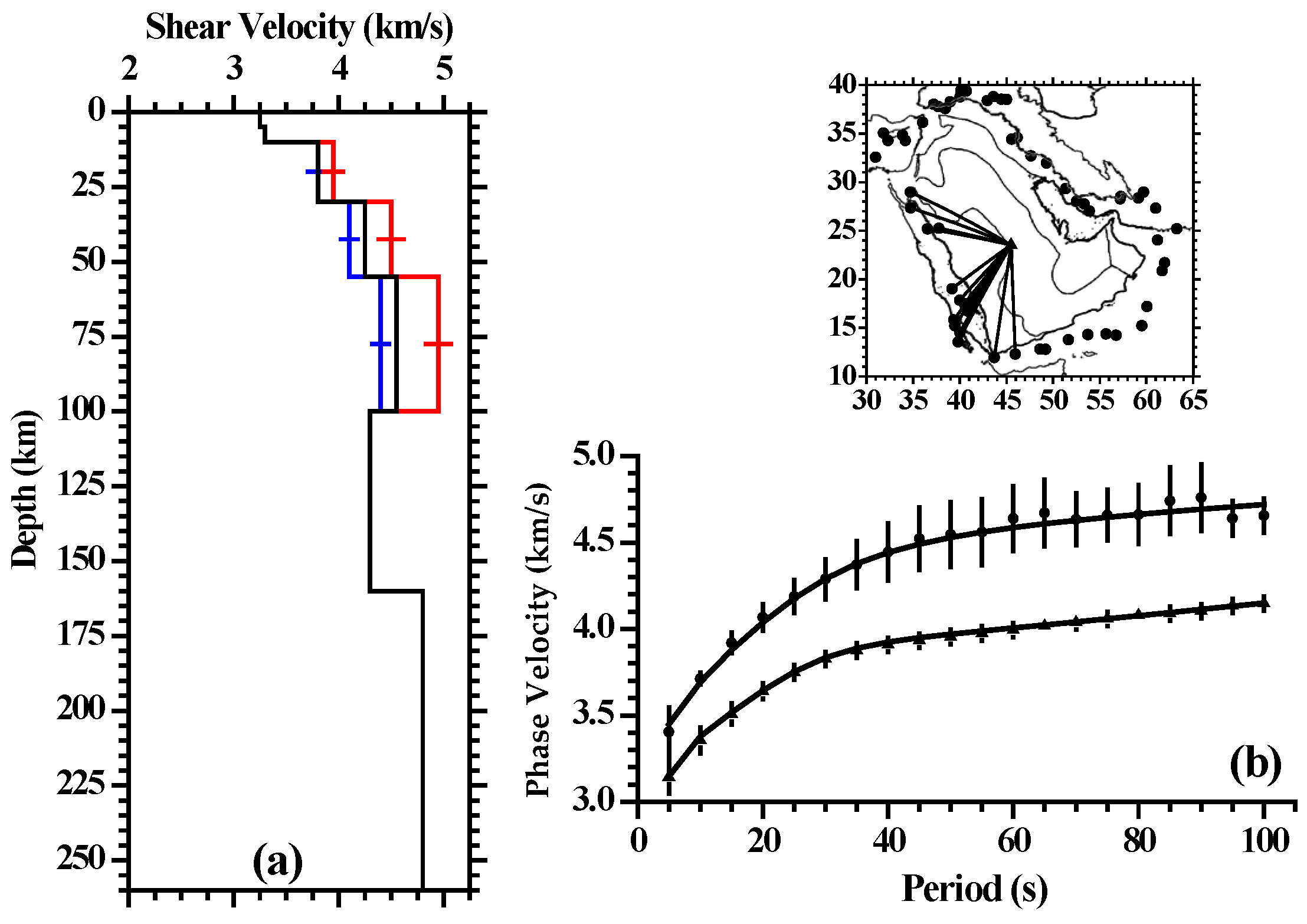
| Thickness (km) | α (km/s) | β (km/s) | ρ (g/cm3) |
|---|---|---|---|
| 5 | 5.63 | 3.25 | 2.30 |
| 5 | 5.72 | 3.30 | 2.77 |
| 20 | 6.58 | 3.80 | 2.85 |
| 25 | 7.36 | 4.25 | 3.20 |
| 45 | 7.88 | 4.55 | 3.35 |
| 60 | 7.45 | 4.30 | 3.40 |
| 100 | 8.31 | 4.80 | 3.53 |
| 140 | 8.31 | 4.80 | 3.60 |
| 100 | 9.41 | 5.09 | 3.64 |
| 100 | 9.72 | 5.26 | 3.84 |
| 40 | 9.97 | 5.26 | 4.08 |
| 30 | 10.54 | 5.70 | 4.16 |
| 130 | 10.68 | 5.85 | 4.22 |
| 200 | 11.10 | 6.26 | 4.43 |
| 200 | 11.48 | 6.44 | 4.61 |
| 200 | 11.78 | 6.54 | 4.74 |
| 200 | 12.06 | 6.64 | 4.83 |
| 12.32 | 6.75 | 4.92 |
| Depth (km) | Region 1 | Region 2 | Region 3 | Region 4 | Region 5 | Region 6 |
|---|---|---|---|---|---|---|
| 10–30 | 1.08 ± 0.08 | 1.05 ± 0.08 | 1.29 ± 0.10 | 1.25 ± 0.11 | 1.27 ± 0.10 | 1.05 ± 0.08 |
| 30–55 | 1.20 ± 0.10 | 1.02 ± 0.07 | 1.02 ± 0.07 | 1.00 ± 0.08 | 1.14 ± 0.07 | 1.05 ± 0.09 |
| 55–100 | 1.27 ± 0.10 | 1.14 ± 0.08 | 1.09 ± 0.07 | 1.09 ± 0.07 | 1.13 ± 0.07 | 1.00 ± 0.09 |
Disclaimer/Publisher’s Note: The statements, opinions and data contained in all publications are solely those of the individual author(s) and contributor(s) and not of MDPI and/or the editor(s). MDPI and/or the editor(s) disclaim responsibility for any injury to people or property resulting from any ideas, methods, instructions or products referred to in the content. |
© 2024 by the author. Licensee MDPI, Basel, Switzerland. This article is an open access article distributed under the terms and conditions of the Creative Commons Attribution (CC BY) license (https://creativecommons.org/licenses/by/4.0/).
Share and Cite
Corchete, V. Azimuthal Variation in the Surface-Wave Velocity in the Arabian Plate. Appl. Sci. 2024, 14, 5142. https://doi.org/10.3390/app14125142
Corchete V. Azimuthal Variation in the Surface-Wave Velocity in the Arabian Plate. Applied Sciences. 2024; 14(12):5142. https://doi.org/10.3390/app14125142
Chicago/Turabian StyleCorchete, Víctor. 2024. "Azimuthal Variation in the Surface-Wave Velocity in the Arabian Plate" Applied Sciences 14, no. 12: 5142. https://doi.org/10.3390/app14125142




